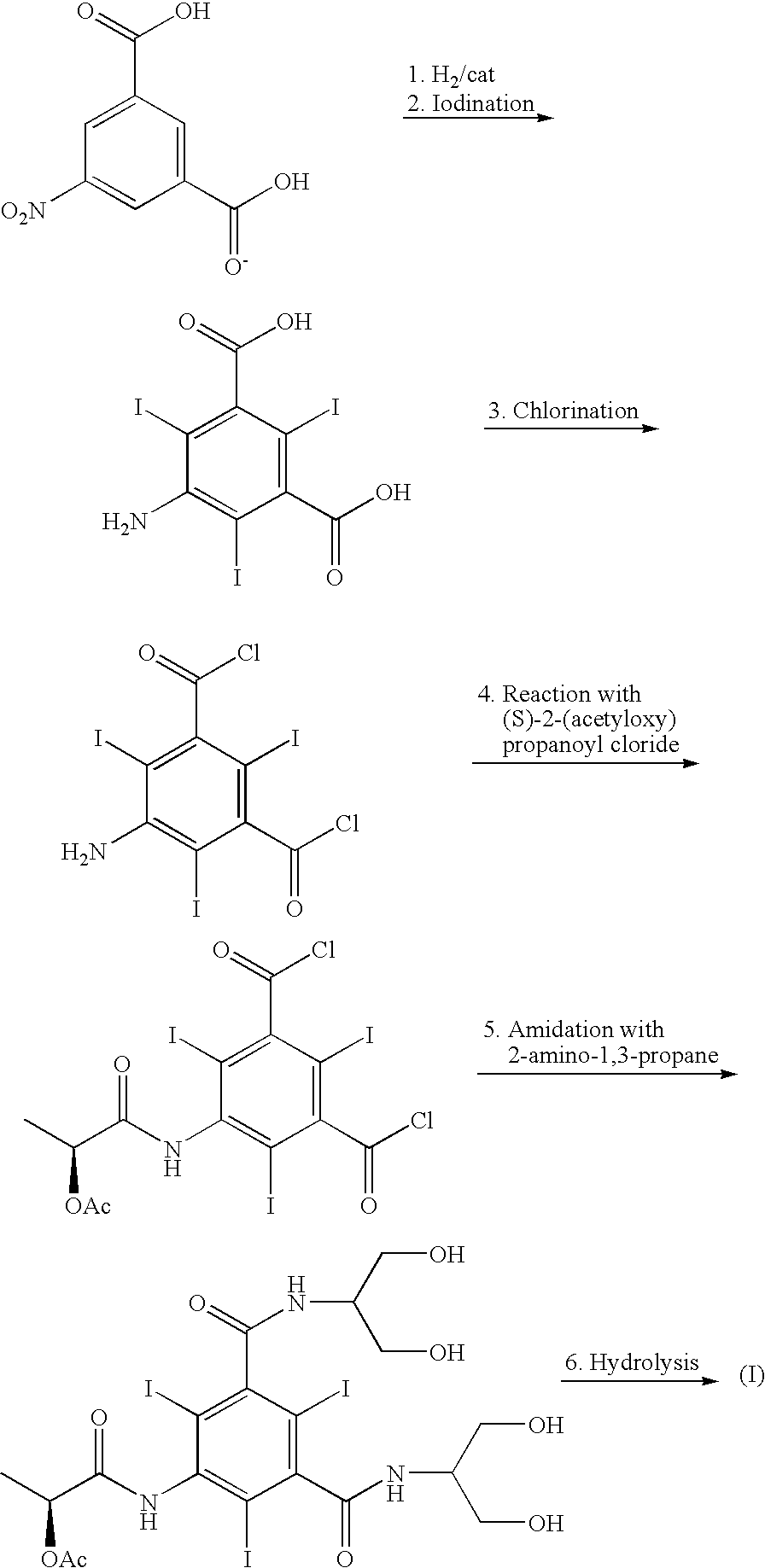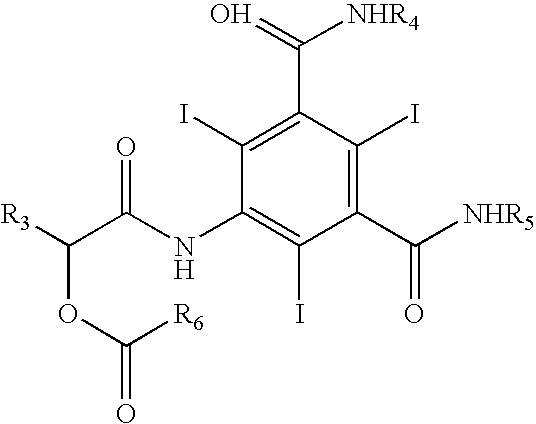Process for the preparation of iopamidol and the new intermediates therein
a technology of iopamidol and new intermediates, which is applied in the preparation of carboxylic acid amides, chemistry apparatus and processes, organic chemistry, etc., can solve the problems of wasting expensive reactants and wasting them
- Summary
- Abstract
- Description
- Claims
- Application Information
AI Technical Summary
Benefits of technology
Problems solved by technology
Method used
Image
Examples
example 1
Preparation of 5-amino-N,N′-bis(2,2-dimethyl-1,3-dioxan-5-yl)-2,4,6-triiodo-1,3-benzenedicarboxamide ((III): —R=a group A wherein R1 and R2=methyl)
[0063] 2,2-Dimethoxypropane (9.5 mL, 77.8 mmol) and 98% sulfuric acid (0.25 g, 2.6 mmol) are dripped into a 0.5 L vessel containing a solution of the compound of formula (II) (18.3 g, 25.9 mmol) (prepared as described in GB1472050) in dimethylacetamide (90 mL) stirred at room temperature. After 20 hours under stirring the solution is neutralised with NaHCO3 and concentrated under vacuum. Acetone (250 mL) and 3% aq. NaHCO3 (50 mL) are then added to the obtained oily residue and the solid is recovered by filtration and crystallized from 70% ethanol to give the compound of the title (13 g, 16.5 mmol after drying).
[0064] Yield: 64%
[0065] The 1H-NMR, 13C-NMR, IR and MS are consistent with the indicated structure.
EXAMPLE 2
Preparation of 5-amino-N,N′-bis(2-ethoxy-1,3-dioxan-5-yl)-2,4,6-triiodo-1,3-benzenedicarboxamide ((III): —R=a group A w...
example 2
bis
Alternative Preparation of of 5-amino-N,N′-bis(2-ethoxy-1,3-dioxan-5-yl)-2,4,6-triiodo-1,3-benzenedicarboxamide ((III): —R=a group A wherein R1 is hydrogen and R2 is ethoxy)
[0070] Triethyl orthoformate (18.6 g, 125.5 mmol) is added over 3 min to a solution of the compound of formula (II) (40 g, 57 mmol) and methanesulfonic acid (0.55 g, 5.7 mmol) in N,N-dimethylacetamide (400 mL), stirred at room temperature. After 15 min, the reaction mixture is neutralized with 1M NaOH (5.7 mL, 5.7 mmol) and N,N-dimethylacetamide is distilled to give an oily residue. The latter is poured into 1% aq. NaHCO3 causing the formation of a white precipitate that, after 15 h under stirring, is recovered by filtration, washed with H2O and dried. The solid is then suspended in absolute ethanol (600 mL), refluxed for 3 hours and allowed to cool to room temperature. The solid is recovered by filtration, washed with EtOH (30 mL) and dried to afford the compound of the title (40 g, 48.95 mmol) as a white so...
example 3
bis
Alternative Preparation of N,N′-bis[2-acetyloxy-1-[(acetyloxy)methyl]ethyl]-5-amino-2,4,6-triiodo-1,3-benzenedicarboxamide ((III): —R is a group B where R3 is methyl)
[0076] The compound of formula (II) (1486 g, 2.1 mol) is loaded into a 10 L reactor containing N,N-dimethylacetamide (1.7 L) and 4-dimethylamino-pyridine (12.9 g) is then added thereto. Acetic anhydride (0.9 kg, 8.82 mol) is dripped therein over about 1 hour keeping the temperature below 30° C. The reaction mixture is stirred at room temperature for 20 hours, and then diluted with 96% ethanol (7.5 L). The precipitate is filtered, washed with 96% ethanol (2×1 L) and dried to give the compound of the title (1715 g, 1.96 mol).
[0077] Yield: 94%
[0078] The 1H-NMR, 13C-NMR, IR and MS are consistent with the indicated structure.
PUM
| Property | Measurement | Unit |
|---|---|---|
| temperatures | aaaaa | aaaaa |
| temperature | aaaaa | aaaaa |
| temperature | aaaaa | aaaaa |
Abstract
Description
Claims
Application Information
 Login to View More
Login to View More - R&D
- Intellectual Property
- Life Sciences
- Materials
- Tech Scout
- Unparalleled Data Quality
- Higher Quality Content
- 60% Fewer Hallucinations
Browse by: Latest US Patents, China's latest patents, Technical Efficacy Thesaurus, Application Domain, Technology Topic, Popular Technical Reports.
© 2025 PatSnap. All rights reserved.Legal|Privacy policy|Modern Slavery Act Transparency Statement|Sitemap|About US| Contact US: help@patsnap.com



